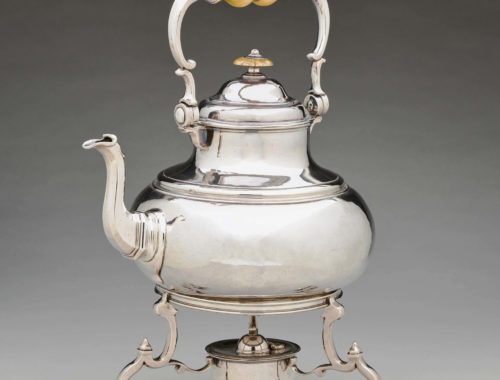Object Number: #908
London 1721/2
Maker: Richard Bayley
City hallmark: figure of Britannia (Jackson 1921: 84)
Maker’s mark: Monogram „BA“ in a curved shield for Richard Bayley (Grimwade 1990, nr. 116)
Assay mark: lion’s head erased (Jackson 1921: 84)
Date letter: “F” in pointed shield for 1721/2 (Jackson 1921: 85)
Dimensions: Height: 23,5 cm (9,05 in.); weight: 980 gr
Detailed Information
Fine George I Silver Teapot on Stand
The teapot with bulbous pear-shape has a smooth surface. The cast spout is edged and ends up in a bird’s head shape. The shoulders and the rim of the press-in lid are profiled. The knob of the lid is made of bone. The swivel handle is attached with two hinges. The three, ear shaped feet of the base are cast and stand on a small hexagonal basis. In the middle the spirit lamp. An excellent example of great finesse.
Teapots – like coffeepots – developed in the seventeenth and eighteenth century their own particular shape. Both beverages were served though warm. The present teapot corresponds to the early type of English teapots, which had a pear-shape. At their early period, they were hardly decorated.
Teapots with a burner were invented in order to boil the tea water above a spirit lamp and then use it to prepare the tea using tealeaves. To this kettle with heater belonged often a silver table with similar decoration, an object known only to England (cf. Hernmarck 1978, fig. 303).
The silver Britannia Standard in the English finesse system has lasted from 1697 to 1720. This standard meant a 95,84% of silver content (on the contrary of 92,5 % by sterling). The figure of a woman commonly called Britannia and the lion’s head erased (torn off at the neck) became the new marks for London of this period. Though not compulsory, after 1720, the Britannia Standard was sometimes used as an alternative standard. A piece of Britannia Silver assayed in 1721 would thus bear the date letter “F”.
Maker
Richard Bayley was son of Anthony Bayly of Hampton, near Highworth. He apprenticed to Charles Overing from 1699 to 1704 and became a master maker on 1706. His first entered mark dates since 1708. His name is traced in a petition in 1711 about the necessity of seven years of apprenticeship on behalf of foreigners (mostly Huguenots) who gave their work for assaying. Richard Bayley produced good quality silver, with decoration, like tankards, jugs, coffee and tea-pots. Some of his fine works are in the Victoria & Albert Museum (s. Grimwade 1990: 434-5).
Literature
Grimwade, Ar., London Goldsmiths 1697-1837. Their marks and lives from the original registers at Goldsmiths’ Hall and other sources, GB: Faber and Faber, 1990
Hernmarck, Carl, Die Kunst der europäischen Gold- und Silberschmiede von 1450 bis 1830, C.H. Beck Verlag: München, 1978
Jackson, Ch., J., English Goldsmiths and their marks, London: MacMillan and Co. Limited, 1921




